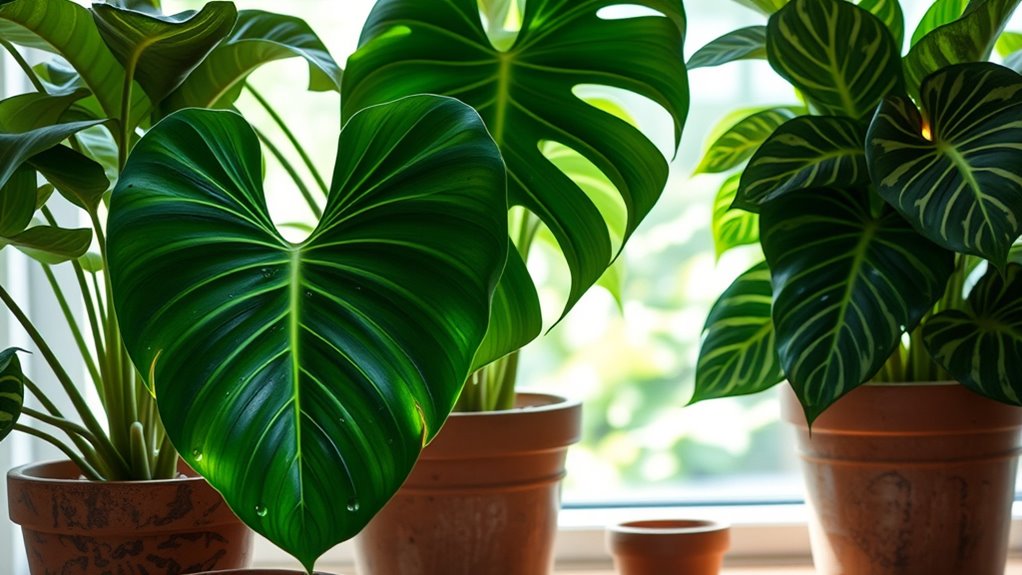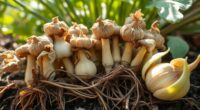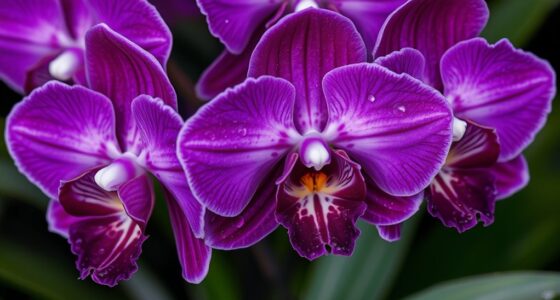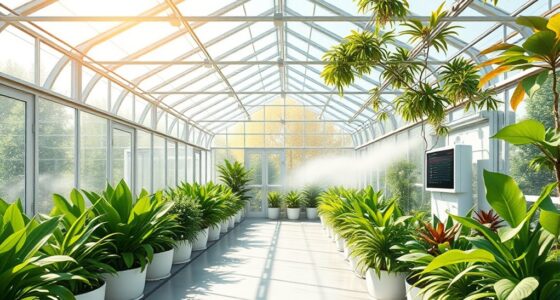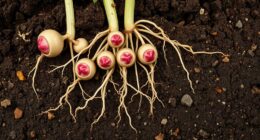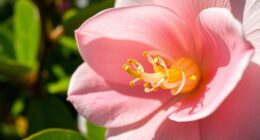To care for rare tropical plants in a temperate summer, you’ll want to keep humidity levels between 60-80%. Use trays of water and pebbles under your pots, mist leaves regularly, and consider a humidifier for consistent moisture. Keep pests at bay by inspecting plants often, maintaining airflow, and cleaning surfaces. Balancing these conditions helps your plants thrive, and exploring effective methods can make all the difference in their health and vibrancy.
Key Takeaways
- Maintain humidity levels between 60-80% using trays, misting, or humidifiers to mimic tropical conditions.
- Regularly inspect plants for pests and use natural treatments like neem oil to prevent infestations.
- Ensure proper airflow and avoid overwatering to reduce fungal issues and pest attraction.
- Place plants away from direct air conditioning or fans to prevent drying out leaves.
- Use air purifiers and keep the environment clean to support healthy growth in a temperate indoor setting.

Tropical plants bring vibrant color and lush greenery to any space, but they require specific care to thrive outside their natural habitats. When you’re growing these plants in a temperate summer climate, understanding how to maintain the right environment is essential. One of the most critical aspects is humidity control. Most tropical plants thrive in high humidity levels, often between 60% and 80%. In a temperate climate, summer air tends to be drier, especially if you’re using air conditioning or fans. To mimic their natural environment, you might need to increase humidity around your plants. You can do this by placing a humidity tray filled with water and pebbles beneath your pots, misting the leaves regularly, or using a humidifier. Consistent humidity helps prevent leaf browning and encourages healthy growth.
Maintain high humidity levels with trays, misting, or humidifiers to support healthy tropical plant growth in dry summer air.
Equally important is pest prevention. Tropical plants are particularly susceptible to pests like spider mites, aphids, and mealybugs, which can quickly infest your indoor or outdoor garden if not managed properly. Keeping pests at bay starts with regular inspection. Check the undersides of leaves and stems for any signs of unwanted visitors. Maintaining proper airflow around your plants also discourages pest buildup, as stagnant air creates a perfect environment for pests to settle and reproduce. Avoid overwatering, which can lead to fungal issues and attract pests, and ensure your pots have good drainage.
When you notice pests, act swiftly by removing affected leaves and treating your plants with natural insecticidal soap or neem oil. Quarantining new plants before introducing them to your collection can prevent pests from spreading. Also, keep your environment clean—regularly wipe down surfaces and remove fallen debris that could harbor pests or disease.
In addition to pest prevention, using air purifiers with HEPA filters can help improve indoor air quality around your plants, reducing dust and airborne contaminants that might stress or harm them. Balancing humidity and keeping pests in check isn’t just about protecting the plant’s health; it directly impacts their growth and vibrancy. You’ll notice that with proper humidity control, your tropical plants develop lush, vibrant foliage, and pest prevention measures keep them free from damage. This combination allows your plants to flourish, even in a climate that isn’t naturally suited for them. Remember, the key is consistency—monitor conditions daily, adjust as needed, and stay vigilant for pests. With these steps, your tropical plants can thrive, bringing that tropical paradise feel into your temperate summer space.
Frequently Asked Questions
How Do I Prevent Pests on My Tropical Plants?
To prevent pests on your tropical plants, start by regularly inspecting them for signs of trouble. Use natural pest repellents like neem oil or insecticidal soap to keep bugs away. Additionally, introduce beneficial insects such as ladybugs or lacewings to naturally control pest populations. Combining these methods creates a balanced approach, helping your plants stay healthy and pest-free without harmful chemicals, especially during warm summer months.
What Are the Signs of Overwatering in Tropical Species?
When overwatering tropical plants, you might notice watering stress signs like yellowing leaves, wilting despite moist soil, or mold on the surface. Root rot symptoms include black, mushy roots and a foul smell. To prevent these issues, check soil moisture regularly and make sure proper drainage. If you see these signs, cut back on watering and let the soil dry out to protect your plants from damage.
Can I Grow Tropical Plants Indoors Year-Round?
Sure, you can grow tropical plants indoors year-round if you provide perfect conditions. Focus on fulfilling their needs by maintaining moderate indoor humidity and meeting their light requirements—bright but indirect light often works best. With consistent care, you’ll create a cozy, controlled climate that mimics their native environment, encouraging healthy growth and happy plants. Keep an eye on moisture levels and lighting, and you’ll successfully sustain tropical plants indoors throughout the year.
How Do I Acclimate Tropical Plants to Outdoor Conditions?
To acclimate your tropical plants to outdoor conditions, start by gradually increasing their exposure to outdoor plant humidity and shade requirements. Move them outside for a few hours daily, then slowly extend this period over a couple of weeks. Keep an eye on temperature fluctuations, and protect plants from direct harsh sunlight initially. This slow progression helps prevent shock, ensuring your plants adapt comfortably to their new environment.
What Soil Mix Is Best for Tropical Plants in Temperate Climates?
Imagine a lush rainforest floor—your tropical plant’s ideal home. To create this, use a well-draining soil mix with organic matter, like peat moss or compost. Add soil amendments to boost nutrients and incorporate drainage solutions, such as perlite or coarse sand, to prevent waterlogging. This blend mimics their natural habitat, supporting healthy roots and vibrant growth, even in a temperate climate.
Conclusion
With a little effort, you can turn your temperate summer into a tropical oasis, nurturing those rare plants like precious jewels. Remember, they thrive with warmth, humidity, and care—like whispers of a rainforest. By giving them your attention, you create a lush escape that blooms against the odds, proving that even in cooler climates, your tropical treasures can flourish and bring vibrant life to your home. Keep nurturing, and enjoy your jungle paradise.

